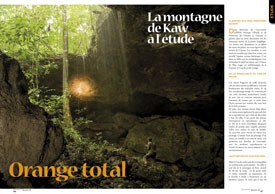23 january 2010, 9AM, mOUNT Kaw
Two volunteers from the Group for the Study and Protection of Birds in French Guiana (GEPOG, ‘Groupe d’Etude et de Protection des Oiseaux en Guyane’) slide down into the ravine leading to the vast expanse of marshes on the Angélique plain. It is the beginning of the rainy season and there are a lot of heavy showers in the region, the wettest in French Guiana. Small streams have swollen into torrents, cutting through the thick lateritic crust which lies in their paths. It is in these gullies that the ornithologists are going to look for the nest of a bird which, like the red Ibis, is emblematic of French Guiana: the Guianan cock-of-the-rock.
The unique nature of the Cock-of-the-rock
This average-sized fruit-eating bird (30cm) mainly owes its fame to the flamboyant beauty of the males. Its bright orange plumage crowned with a prominent circular crest and edged with black creates a striking contrast when spotted against the brownish green background of the primal forest undergrowth.
Furthermore, not only does the bird have a proud appearance, it also offers quite a spectacle during the breeding season running from December to May. It is one of the neotropical birds to mate in a lek. Lek is the scientific word for the display arena in which several males use the variation of light in the undergrowth to show off their plumage to their best advantage. As the state of a bird’s plumage is an indication of its health, this enables the females to mate with the best breeders and give birth to chicks that are best adapted to their environment.
The situation at Kaw…
Nevertheless, the cock-of-the-rock pays the price for these interesting particularities: peace and quiet. The only lek on the 40km long massif of Mount Kaw is a small one (with a maximum of five males overall). Word of mouth has also spread over the past six years, meaning that more and more people know about and visit the site. It is so attractive today that on some weekends over 100 people come to watch the males’ display.
To make matters worse, its main breeding colony, which includes up to 6 nests, happens to be situated in a cave which is becoming increasingly more popular with tourists.
… and elsewhere in French Guiana
The name of this species tells us a lot about the bird: it is a “cock” because of its crest and “of the rock” because its nests are always found in caves or sheltered under rocky overhangs. In French, the local language, ‘orange’ is also included, referring to the male’s eye-catching plumage.
As the male always stays on his own personal parade ground, the female is solely responsible for building the nest. She begins by making or replenishing the nest in the semi-darkness of cave’s entrance so as to be sheltered from the bad weather. On Kaw, the nests are found between two and eight metres off the ground, placing them out of reach of predators such as snakes and wild cats. The female weaves together small black roots and mud mixed with saliva and plant sap, which allows her to glue the nest to the rocky surface.
Cock-of-the-rocks in French Guiana therefore live solely in the mountains: the only habitat which offers both untouched primal forest and large rocky overhangs.
Consequently, there are large areas where the bird cannot live and so it can only be found in patches here and there. As each patch has a small population, this species is considered rare and fragile throughout the region. This has led to the species being classified on the list of fully protected birds (whose sale, destruction, transport, and so on, is entirely prohibited).
As things stand across the department as a whole, gold mining is the main human activity threatening the Cock-of-the-rocks and infringing upon their territory, especially primary gold mining as the main deposits of primary gold are found in the mountains zones.
The first steps to protection
Having identified the main dangers on Mount Kaw, various partners have come together to act and maintain the species on site. This group is made up of an association, GEPOG, which offers its scientific expertise and network of volunteers who are eager to help protect nature, working in association with institutional partners: the French National Forestry Office (ONF, or ‘Office Nationale des Forêts’) which manages the site and has overseen works carried out there, the Regional Nature Park of French Guiana which carried out the tourist survey, and the Regional Directorate for the Environment (DIREN, ‘Direction Régionale de l’Environnement’).
The first protective measure was to inform people going to the lek about the simple precautions that can be taken to enjoy the show without bothering the animals (remaining at a certain distance, being patient, not using flash photography, moving around in small groups, not taking a dog, etc.). The public has also been given information about the correct way to set up a hide so as to remain better concealed.
In addition to this, a barrier has been set up in front of the cave to dissuade people from going down into it. Between November and June, when the females are on the site, they could even abandon their eggs if disturbed by walkers.
Alongside this, GEPOG has also launched a study across the massif so as to gather the first scientific data about the state of the population of the Guianan cock-of-the-rocks on Mount Kaw.
The study
The study began in 2007 and finished in August 2010. The first aim is to find as many sites as possible and record their GPS position so that they can be reached easily. The GEPOG database used for this purpose has been joined by on-site prospecting and interviewing. Long working days on site are necessary in conditions that can sometimes make progress difficult. The greatest possible vigilance is required as the thick vegetation can mask areas of major land slippage. Nevertheless, these efforts have paid off and the details about the location of the fourteen nesting sites on the mountain have been updated. It has come as a real surprise to discover that the females sometimes nest as far as twenty kilometres away from the site of the lek.
Following this, the nests are being monitored for three years, with the number of eggs and chicks being counted regularly. This is a delicate operation as it is a matter of obtaining the data without causing the mother to abandon her clutch of eggs, for the species is protected by law. The people in charge of this project have received training and special authorisation from the French National Museum of Natural History (‘Muséum National d’Histoire Naturelle’) operating under the authority of the Ministry for Ecology.
The results
Although the study is not yet entirely concluded, the initial results of the study can be presented.
The cock-of-the-rocks on Kaw present the same breeding parameters as their neighbours in Surinam and Brazil, laying on average a little under 2 eggs per year. The brooding period lasts 29 days, the rearing of the young lasts 33 days, and the females look after the chicks properly. One characteristic of this massif population is its diet: they feed on fruits found in the forest and especially those of the açai palms. This is not surprising given that this palm covers hundreds of hectares at the foot of the mountain and around the marshes, producing a fruit of good nutritional quality.
It turned out, however, that other parameters fluctuate extensively. For example, whether or not a site is occupied varies from one year to the next without it being possible to determine the reasons for this change. The nesting season can also be very long (seven months from November to June, amounting to over half the year in total) or short (from February to June). The number of occupied nests on the massif as a whole can also vary.
Forthcoming results
In two months’ time, the data collected over the past three years will have been processed. It will then be possible to show the impact humans have had on the nesting sites. This will provide a solid basis for monitoring the state of the population in the future.
Alongside this, GEPOG will be launching an even more ambitious study with EU funding as part of the LIFE+ programme, which will seek to add to our knowledge about the Kaw massif and French Guiana as a whole. The aim is to monitor the dynamics and count the number of birds, to map their preferred habitat by following certain birds with radio tags, and to estimate population movements between mountain massifs. Once again, the end goal is to provide the most specific and reliable information possible so as to enable the relevant institutions to effectively protect the species, so that future generations can also admire this amazing and emblematic bird.




 English
English Français
Français  Português
Português 











 Télécharger l'article en PDF est réservé aux abonnés Web !
Télécharger l'article en PDF est réservé aux abonnés Web ! 
 Pas de réaction
Pas de réaction Comment!
Comment!


 Voyages avec Tooy. Histoire, mémoire, imaginaire des Amériques noires : Editions Vents d’ailleurs, 2010
Voyages avec Tooy. Histoire, mémoire, imaginaire des Amériques noires : Editions Vents d’ailleurs, 2010
 Guyane. Produits du terroir et recettes traditionnelles. L’inventaire du patrimoine culinaire de la France : Editions Albin Michel, 1999
Guyane. Produits du terroir et recettes traditionnelles. L’inventaire du patrimoine culinaire de la France : Editions Albin Michel, 1999
 Alunawalé, un voyage à travers les milieux naturels de Guyane : Office National des Forêts, 2009
Alunawalé, un voyage à travers les milieux naturels de Guyane : Office National des Forêts, 2009
 Augusta Curiel, Fotografe in Suiriname 1904 – 1937 : Libri Misei Surinamensis, 2007
Augusta Curiel, Fotografe in Suiriname 1904 – 1937 : Libri Misei Surinamensis, 2007


